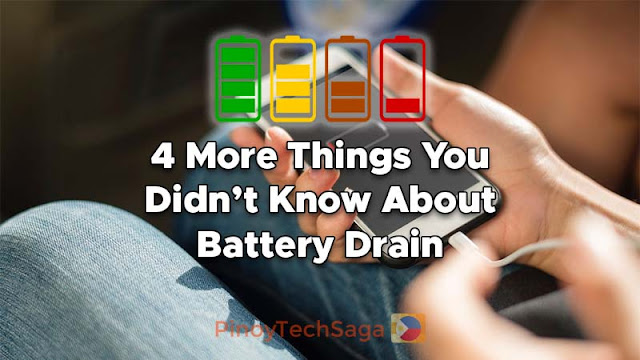
Most of us probably have complained about our phone battery didn't last long as it was supposed to. But did you ever ask yourself why this might be the case? Several factors affect battery life, such as battery size, display, wireless connections, chipset, camera, temperature, active apps, passive apps, operating system, and background tasks. Aside from these, there are still four more things you probably didn't know about battery drain.
1. You're receiving a notification saying an app uses a lot of power, even though you didn't open the app.
The app may have been set to launch automatically when you start up your phone, which is why it is now consuming battery. Most Android phones have the feature of managing app launch. You can then set whether you want to enable automatic launch for this app and allow it to run in the background, or disable it from autostart.
2. The estimated remaining battery life and charge time are sometimes inaccurate.
Most Android phones' battery management feature estimates the remaining battery life based on your recent usage and the charge time based on the current battery level and battery usage. These are estimates only and can differ from the actual time span, depending on your actual battery usage.
You might also like: How to check Android phone's battery capacity via PC
3. The battery seems to drain faster when it's at a low level.
The level of battery you see may not always be up to date. Your phone can't calculate its battery level if you're using it always or several apps are running in the background. Meaning, the displayed battery level can be higher than the actual level. The phone will automatically calibrate the remaining power when the actual battery level drops below 3%, and the percentage will refresh. When this happens, it may look as though the battery level has suddenly dropped.
Also read: Calibrate Android Battery (The Proper Way)
Your phone will automatically turn off until the remaining power is used to avoid battery damage due to excessive discharge, making it look as though there was less battery than the displayed percentage indicated.
When the battery level is low, the system frequently requests battery level information to ensure that the percentage you see is as accurate as possible. During this time, you can save important data or charge your phone as soon as possible to prevent data loss, but it also consumes some power. You can go to your phone's battery settings and enable power saving mode to extend the standby time.
4. The battery always seems to drain faster when your phone has been updated to a new version.
This is because certain optimizations are still performed in the background after the update (major OS software upgrade or system update) is finished, including app re-configuration and optimization, reorganization of your photos in Gallery, and file scanning to prevent security risks. Your phone will return to normal once these optimizations are complete. If you still think the battery is draining too fast, back up your data and go to your respective authorized service center.
How to improve your Android phone's battery life
1. Check apps that can cause battery drain
To check which app uses the most battery, in most versions of Android, hit Settings > Device > Battery or Settings > Power > Battery Use to see a list of all apps and how much battery power they're using. (In Android 9 Pie, it's Settings > Battery > More > Battery Usage.) If an app you don't frequently use seems to consume an excessive amount of power, consider uninstalling it.
The app would typically appear at the top of your battery usage list if you use an app too much. Try to spot some anomalous activity, especially in apps that you haven't actively used in a while. Some apps run in the background, causing excessive Android battery drain, without you even knowing it. This kind of apps appears to be poorly designed apps.
2. Remove unnecessary widgets from the home screen
Many Android apps, such as social media apps, weather apps, and news apps, feature widgets which are handy for real time updates on your home screen. However, widgets are battery drainers because of their constant syncing process, or heavy animations that consumes more battery. If you don't need a chat head for Facebook, or daily weather alerts, remove the widget, just press and hold the app icon, then drag it to the trash can.
3. Switch on Airplane Mode in low-signal coverage areas
When attempting to communicate in low-signal areas, smartphones use more power. Switch on Airplane Mode by swiping down and pressing the Settings wheel if you can't get a signal. Instead of staying connected through mobile data, you can switch on Wi-Fi (with Airplane Mode enabled) if your low-signal area is, say, an office or someone's home. When you're in a place with better signal coverage, then restart your mobile connection.
4. Turn off other features like NFC, GPS, Vibration, Bluetooth, and Wi-Fi when not in use
These features consume a considerable amount of battery. So if you are not using them often, you can safely turn them off. Just go to the settings of your phone and find the menu for each respective feature.
5. Turn off notifications
Having real-time updates on what is going on in your apps is useful for items like emails or social networks. Still, for purposes that are much less useful, many apps automatically need permission to send notifications. Just go to Settings > Apps, turn off notifications, then visit unnecessary apps, and uncheck "Show notifications."
6. Adjust display settings
Enable "automatic brightness" or "adaptive brightness" of the phone to adapt the display based on the current lighting condition, to ensure the screen is never brighter than necessary.
But if your battery is in bad shape, a decent temporary workaround until you can get to a charger is to dim the screen manually. Pull down the notification dropdown menu and drag the brightness slider to the very dimmest display level you're most comfortable with.
7. Avoid using live wallpapers
Live wallpapers are cool but can contribute to battery drain. The more battery-friendly alternative is regular wallpapers. For AMOLED display, dark wallpapers with lots of blacks are even better.
8. Prevent your phone from overheating
The batteries on the phone should be neither too hot nor too cold. The ideal temperature range is around 68°F (20°C) to 86°F (30°C) for smartphone batteries. If a phone is usually left outside this range of temperatures, especially on the hotter side, the battery can eventually be damaged.
9. Enable battery saver mode
Battery saver mode or power-saving mode feature helps maximize battery life and stretch out those last several minutes. This mode disables unnecessary services and features (For example, animations are reduced, most background syncing is halted, and location services turned off) to ensure that you can make a call or send a message if needed. To enable this feature, pull down the notification dropdown menu and toggle the battery saver or power saver icon.
What can you say about these tips? Let us know your thoughts by leaving a comment below.












COMMENTS